Understanding Intel's Dynamic Power and Thermal Framework 8.1: Smarter Throttling
by Joshua Ho on August 21, 2015 8:00 AM EST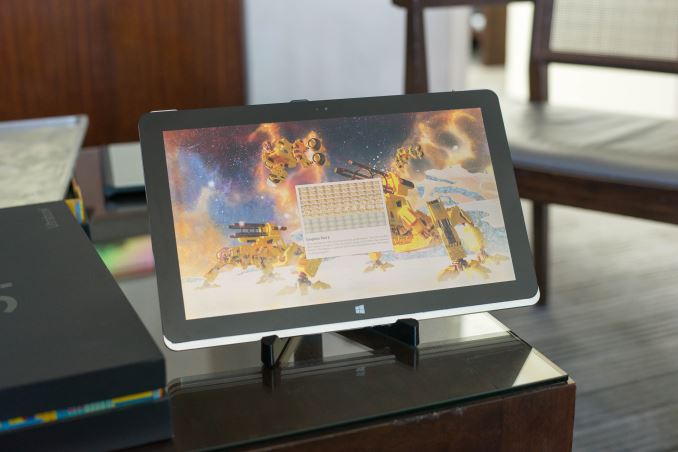
In mobile, thermal throttling is effectively a fact of life as modern, thin tablets and smartphones leave little room for implementing high-performance fans. We can use CMOS scaling to try and reduce the amount of power consumption, but in order to keep up with increasing performance demands it’s important to also scale performance as well.
This means that while performance per watt will increase from generation to generation thanks to manufacturing and architectural improvements, finding ways to allow CPUs to use more power is also part of the equation in order to get the best possible performance out of a passively cooled device. This has been evidenced in recent years by the ever-increasing dynamic power ranges for mobile CPUs, which has seen idle power consumption drop while maximum load power consumption has risen.
By increasing the dynamic range of these CPUs, it has allowed manufacturers to further optimize their devices for workloads that require high CPU performance for only short periods of time, a surprisingly common workload. For the end user then, there’s a clear benefit to both effective turbo and thermal management, as any kind of race to sleep workload sees benefit from turbo clocks, while long-running high-load workloads benefit significantly from smart thermal management.
Although Intel’s Dynamic Platform and Thermal Framework (DPTF) 8.1.x has been out for months now, these features haven’t really received much attention so far. For those that are probably unaware of what Intel’s DPTF is, it’s effectively Intel’s solution to managing throttling in a smart manner according to the TDP limits of the device based upon thermal sensors and power monitoring for x86 tablets, 2-in-1s, and PCs in general. If you think this sounds a lot like ARM’s Intelligent Power Allocation in some ways, you’d be right.
For the most part, previous iterations of DPTF have been pretty standard in the sense that they rely on a fixed correlation between temperature sensors and critical values like Tskin max and Tjunction max of all chips on the board. As these devices are unable to directly read skin temperatures, the system must instead infer what Tskin should be. And once certain temperature sensors read out certain values, the system assumes that the skin temperature has reached a maximum value, which means it’s necessary to begin throttling the system. Similarly, if an on-die chip sensor reads a specific value that is close to the maximum junction temperature, the system will react by throttling appropriately.
However in the case of DPTF 8.1, this system has changed. Instead of a fixed correlation, the system is now adaptive depending upon a number of factors. One of the key examples cited is device orientation, as how a device is placed has a significant impact on its ability to cool itself. For example, when a tablet is placed flat on a table with the display up, the back of the tablet is unable to rely on convection and ambient air flow to cool the back cover. With previous iterations of DPTF, this worst-case style setup was what was used to determine how to correlate temperature sensors with skin temperatures.
The problem with that approach was that when the device was placed in a situation where cooling was better, such as held vertically in the air or held in a dock with a circulation fan, DPTF wouldn’t change the temperature sensor correlations to skin temperature. This meant that in long run TDP-gated situations that the device was throttled to a greater extent than truly necessary.
It turns out this one change has enormous effects on performance in these thermally limited situations. With a vertical orientation, heat dissipation and thereby power headroom increases by 66%. With an active cooling dock, power headroom increases by 97%. As Intel reasons and as their data backs up, there are clear benefits in not being conservative with throttling in situations where physics says cooling performance is better than the worst case scenario.
Of course, system performance won’t increase by quite those levels due to the fact that CPU power draw increases quadratically with clock speed. According to Intel, in benchmarks this leads to an average performance increase of about 35%, with some use cases showing as much as double the performance in this mode.
Ultimately, coming from IDF 2015 it isn’t clear at this time when we can expect this to show up in 2-in-1s, tablets, and other devices. But given that DPTF is a software suite it’s well within possibility that devices already out there with DPTF could receive an update that implements these improved throttling mechanisms.




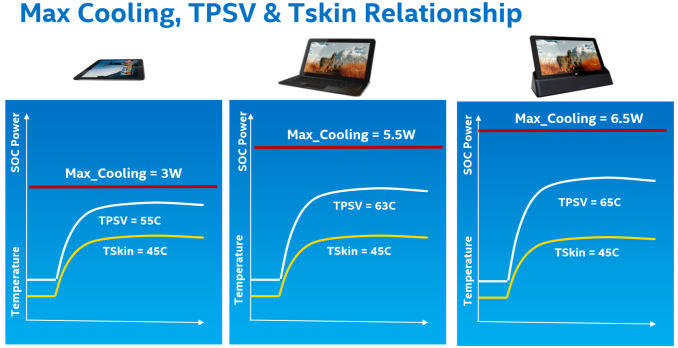
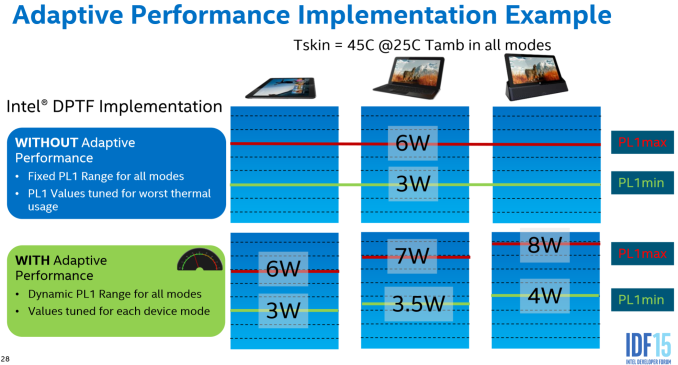
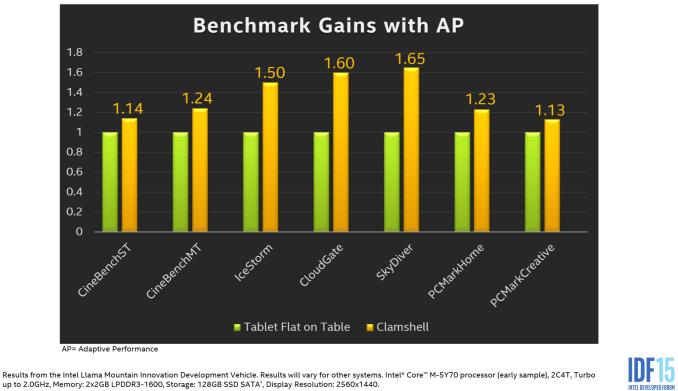
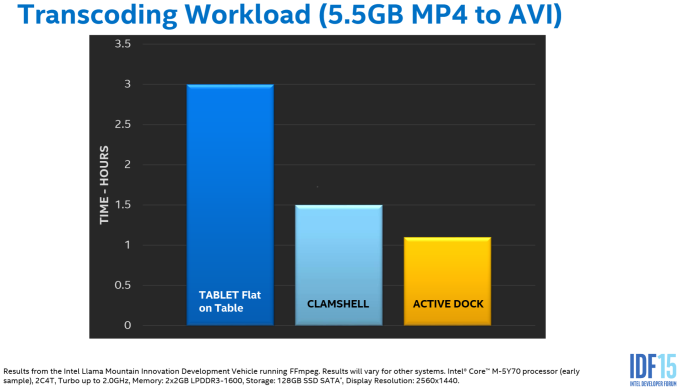








32 Comments
View All Comments
BrokenCrayons - Friday, August 21, 2015 - link
I think that's probably due to the fact that the chassis design can have a lot of variation and the sensors would be the responsibility of the OEM to create and install which means that they may not operate with a degree of precision that Intel would want (and could even compromise performance). Intel's had a history of integration from things like the movement of L2 cache from the motherboard to the CPU package in the Pentium II days to absorbing functions that previously were the responsibility of the chipset and then there's the move from letting OEMs decide what graphics cards to include on the motherboard to the eventual inclusion of the GPU on the processor's die. Giving processor performance control back to the OEM by depending on the correct integration of sensors is likely something that is a task Intel considers too complex to hand off.boeush - Friday, August 21, 2015 - link
The while concept seems like a hokey compromise to me. The CPU isn't the only heat source in a system. If there is a discrete GPU (e.g. in a high-end ultrabook) the CPU isn't even the largest heat source. Then there's the power supply, the chipset, RAM, SSD(s), the screen... The exact spatial arrangement of those components can vary; the cooling design (heat pipes/spreaders, case materials and dimensions, presence of active cooli g or not) can vary greatly.boeush - Friday, August 21, 2015 - link
Nuts, hit "submit" prematurely with my fat fingers... Anyway, even after all that, actual operating co ditions can vary more than a simple orientation sensor can predict. What is the ambient temperature? Is the device in direct sunlight or in the shade? Is the device being held, in a lap, on a warm surface, on a cold surface? What is the wind/airflow around the device like?boeush - Friday, August 21, 2015 - link
Wow, sis it again. Gawd Anandtech, where's that edit button everyone's been requesting for the last umpteen years?Anyway, what I was driving at, is that these sorts of decisions are best left to the BIOS, which has a more complete view and 'understanding' of exact system hardware and design features, and best fed by direct skin temperature sensors rather than simplistic and inherently incomplete abstract models.
ScottSoapbox - Friday, August 21, 2015 - link
I understand how Intel could easily add an orientation sensor internally for improved dynamic power, but how would it determine an external active cooling solution is being used?creed3020 - Friday, August 21, 2015 - link
Intel doesn't need to add any orientation sensor when all tablets already have a gyrometer onboard, just leverage the existing hardware.A dock could also be detected through software. Any enterprise products which support real docks or USB 3.0 docks can easily know that they are currently attached or not through simply software checks against hardware presence.
All in all this peaks well for future devices. Excited to see if this is included within the SP4 ecosystem.
meacupla - Saturday, August 22, 2015 - link
Either a temperature sensor glued to the backside, or some program that keeps track of thermal load vs. hardware workload.junky77 - Friday, August 21, 2015 - link
But I don't get it. Sensors were available before - Weren't some API to the sensors data and the ability to change performance available before?toyotabedzrock - Friday, August 21, 2015 - link
How about placing an molded in temp sensor in the back cover and maybe using something to spread the heat out a bit?Morawka - Friday, August 21, 2015 - link
where is the architecture deep dive in?